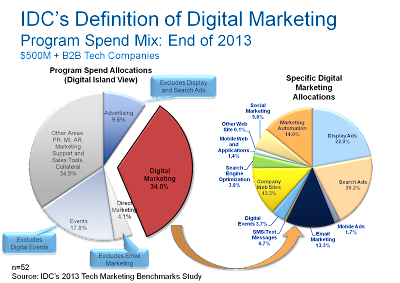Or maybe 2014 will be the year of mobile, or the year content marketing. Ok, Ok, I can guarantee one thing, 2014 will be the year of the horse.
While 2014 might not be the year of digital marketing, digital will continue to be deeply important to the marketing organization. As digital spend continues to increase, the focus grows. Despite this, there can be a lack of clarity around the topic. What exactly falls within digital marketing? How much budget is actually being spent on digital? And how does it all meld together?
Let’s dive in.
Digital Marketing Budget Trends:
From 2009 to the end of 2013 digital marketing program spend has increased from 13% to 34% of the total marketing program mix. For 2014 IDC’s CMO Advisory Service expects this to increase to 39% and to 50% in 2016 (highlighted within
Kathleen Schaub and
Rich Vancil‘s
IDC Chief Marketing Officer (CMO) 2014 Predictions). While this level varies depending on sector and size, the upward trend is clear.
What is Digital Marketing:
At this point all marketers agree that digital is important. That is all well and good, but without a consistent definition around the topic, digital marketing may mean different things to each person or organization. To be successful in building a digital marketing practice, having clear definitions is imperative. This will drive consistency throughout the organization leading to proper tracking and staff allocations. Below is IDC’s definition of which marketing programs fall within “digital marketing.”
For specific definitions for each area please view IDC’s Worldwide Sales, Marketing, and Market Intelligence Taxonomy, 2013.
Digital as an Organizational Practice:
Defining and tracking digital marketing is important, but the modern marketer understands it must be executed in orchestration with the full marketing strategy. A key guidance for 2014 is to create “systems not silos.” In short, rather than creating another walled practice within marketing (think, advertising vs email marketing, vs events), make digital an organizational practice that spans across all tactics and staff. Separating digital and non-digital marketing will create more complex challenges for the organization. Avoid this approach and make digital a strength across all of marketing.
3 Take Aways:
- Digital marketing spend is growing, FAST, it will be 50% of the (multi-billion dollar) B2B tech marketer’s program budget by 2016.
- Work to define digital marketing so everyone in the organization is speaking in the same terms.
- Do not separate digital from the rest of marketing, it is too important to sit on an island.
Now it’s your turn, what are you planning to do within digital marketing for 2014? What other suggestions do you have for your peers? What did I miss?




